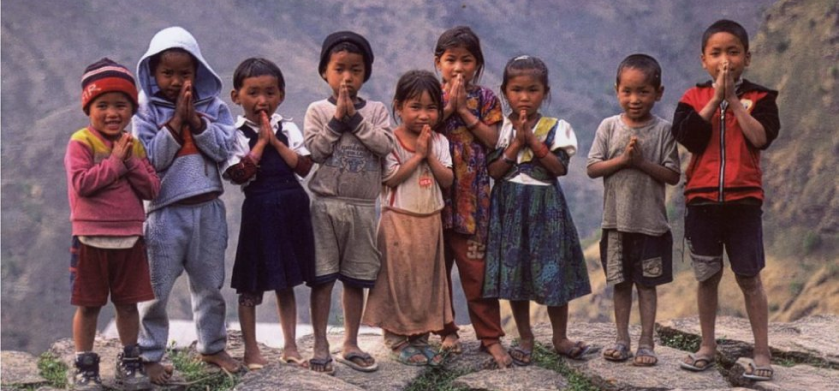31 Jul, 2023
The rural exodus is a tangible reality in Kathmandu. The economic and political capital of the country continues to expand with the emergence of new slums. Children live in extreme precariousness, with family or unaccompanied. During the day, they are left on the street, where some end up living. In this fragile country, children are also trafficked or forcibly uprooted. They all share one thing in common: vulnerability to sexual exploitation.
Since 2008, ECPAT Luxembourg and its Nepalese partners have been fighting this threat. Here is the link to our previous actions in Nepal: Project Nepal closed.
After an acute political crisis, Nepal remains unstable. The socio-economic situation is precarious, especially in rural areas. Many children leave their homes to try their luck elsewhere. The protection of children and the coverage of their basic needs has deteriorated.
Nepal has a population of approximately 13 million children. Of these, more than 4 million live below the poverty line.
In terms of access to basic human needs – shelter, hygiene, water, information, food, education and health – the figures are challenging. 69% of children do not have access to any of these needs, 40% to two of these needs.
With 51% of children between the age of 10 and 15 working, Nepal occupies a sad first place in the world.
The rural exodus is a tangible reality in Kathmandu. The economic and political capital of the country continues to expand with the emergence of new slums. Children live in extreme precariousness, with family or unaccompanied. During the day, they are left on the street, where some end up living. In this fragile country, children are also trafficked or forcibly uprooted. They all share one thing in common: vulnerability to sexual exploitation.
Since 2008, ECPAT Luxembourg and its Nepalese partners have been fighting this threat. Here is the link to our previous actions in Nepal: Nepal Project closed
Nepal has a population of approximately 13 million children. Of these, more than 4 million live below the poverty line.
In terms of access to basic human needs – shelter, hygiene, water, information, food, education and health – the figures are challenging. 69% of children do not have access to any of these needs, 40% to two of these needs.
With 51% of children between the age of 10 and 15 working, Nepal occupies a sad first place in the world.
The civil war in the country over the past 10 years has forced many families to migrate to cities where 16% of the population now resides. This exodus has caused the break-up of extended families, leaving children alone or under-supervised, at least vulnerable to abuse and sexual exploitation.
But insecurity has also driven young boys to flee the countryside to avoid being recruited or persecuted. Separated from their families, these young people arrive in large numbers on construction sites or on the streets of Kathmandu. Again, the risk of being sexually abused or exploited is great. Especially since the country is experiencing a rapid growth of dance bars and other “parlours massages”, places conducive to the sexual exploitation of children.
The main objective of the project is to help combat child abuse and sexual exploitation in Nepal.
Specifically, the project aims to reduce child abuse and sexual exploitation in Nepal by raising awareness, preventing and protecting vulnerable and/or victimized children.
The project is being developed through three local partners, Nepalese NGOs, and is coordinated by the local ECPAT Luxembourg office, where two people work. The main activities are:
National quantitative and qualitative study of the phenomenon of child sexual exploitation
Caring for children and adolescents in foster homes
Outreas on street children
Medical care and psychosocial follow-up
Legal follow-up and assistance if needed
Literacy and schooling
Cultural, sports and educational activities
Restoring family and community ties
Training, awareness and skills building on the sexual exploitation of children of social actors working with children
Raising awareness among community leaders and communities of children’s origins
National campaigns to raise awareness of the scourge of child sexual exploitation, for the general public as well as tourism professionals
The direct beneficiaries of the project are the most vulnerable children and/or victims of abuse and sexual exploitation:
Street children in Kathmandu living or working in the main transit points of the city and in tourist areas.
Children ‘at risk’ from migrant families and/or living in extreme poverty in Kathmandu
Children who are victims of sexual abuse or exploitation
Indirect beneficiaries include:
The families of the children.
Communities and the general public
Local actors (local authorities, police, shopkeepers, hoteliers, teachers, etc.) who are concerned with the problems of street children and the sexual abuse of children.
Government actors
Nepal covers a territory of 147,181 km2 with an extremely diverse terrain that stretches from the plains at less than 100m in the south to the highest mountains in the world to the north. The country’s population is about 29 million, most of whom live in the plains and hills. Nepal’s population is 83% rural. The country is divided into 5 regions and 75 districts.
The interim constitution recognizes decentralization of power, social and political inclusion, democratic elections and political responsibility, which represent important opportunities in this transition. However, the main stages of the peace process have not yet been reached and the drafting of the new Constitution remains slow. This new Constitution must lead to a restructuring of the Nepalese state with the adoption of federalism as a fundamental principle of governance. Elections will be scheduled nationally and locally following the enactment of the constitution.
The conflict and the slow transition to peace and stability have had a significant impact on children. More than 14,000 people, including about 475 children (3%), died. In addition, 8,000 children have been orphaned and 40,000 have been displaced, some to India, others to parents far from home or to urban areas where they have been put to work. At least 562 children have been injured or have severe and permanent disabilities.
Kathmandu: prostitution and sex tourism involving children
Neighbouring districts: trafficking and movement of unaccompanied children
Along the national road to the south: prostitution, trafficking and displacement of unaccompanied children
April 2012 – March 2015 (36 months)
Over 3 years: 1,020.254


We do not show on this site any child victim of sexual exploitation. The few recognizable children are beneficiaries of our prevention actions.
3, rue des Bains - BP 848 L-2018 Luxembourg
Phone : (+352) 26 27 08 09
Fax : (+352) 26 20 06 22
ecpat-luxembourg@ecpat.lu